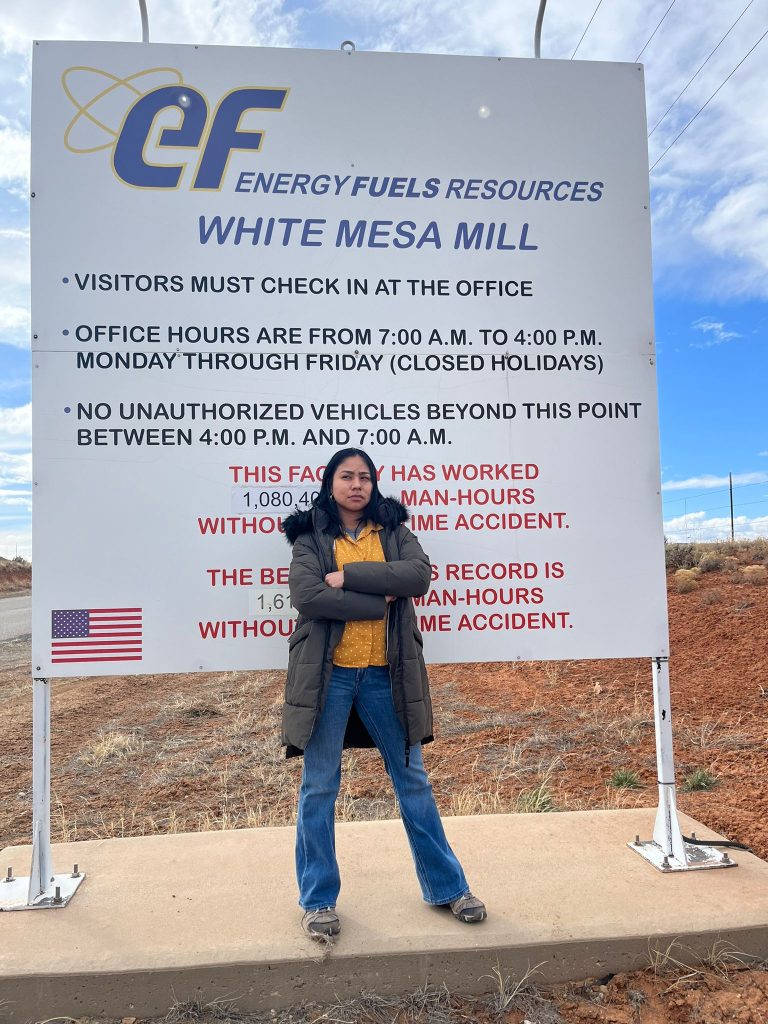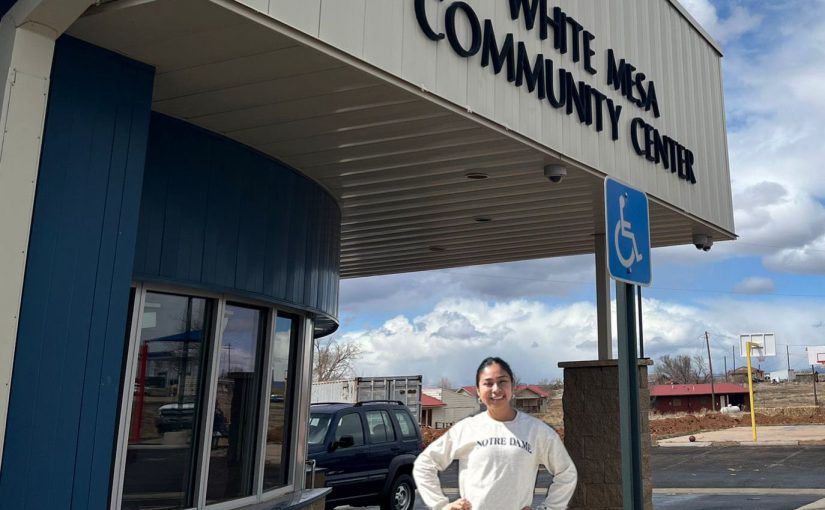By Jailene Castillo
During Notre Dame’s spring break I traveled to an area of the southwestern U.S. known as the Four Corners, the place where the borders of four states meet: New Mexico, Arizona, Colorado and Utah. Along with six other students, I participated in this trip as part of a policy module on resource extraction within the GLOBES Certificate program in Environment and Society. We were guests of the Ute Mountain Ute Tribe.
We learned about environmental and health hazards endangering the residents of the White Mesa Community in White Mesa, Utah in relation to the White Mesa Mill, the only fully licensed and operating uranium mill in the United States.
Members of the White Mesa Community, part of the Ute Mountain Ute tribe, live on a town in the Ute Mountain Ute Indian Tribe reservation in San Juan County, Utah. The White Mesa Mill sits about three miles from the community. The mill’s 10-year license was issued in 1980 by the Nuclear Regulatory Commission (NRC), the federal agency that regulates commercial nuclear power plants. NRC guidelines define the rules that the mill must follow to prevent contamination of groundwater and air with toxic chemicals.
However, Utah transitioned to an agreement state in 2004 marking a significant shift in its regulatory authority over nuclear activities. Utah gained the ability to establish its regulations and enforce compliance with federal standards set forth by the NRC and delegated these tasks to the Utah Department of Environmental Division of Waste Management and Radiation Control and the Division of Air Quality. While the mill submitted its license renewal application to the state in 2007, it was not renewed until 2017; the old license was under timely review, meaning that it remained in effect, allowing the mill to operate on a 20-year license.
This development meant that the Nuclear Regulatory Commission was no longer responsible for overseeing the lawful operation of the mill. The state of Utah was now an autonomous body who was responsible for ensuring that the White Mesa Mill fulfilled its obligations to operate in accordance with the guidelines and to protect residents of the White Mesa Community. The community could now make direct demands from the state, especially in cases where it did not meet its duties.

Due to a decline in domestic uranium mining, the mill now serves as a waste disposal facility for radioactive waste from the U.S. as well as Japan, Canada, and Estonia. Waste is processed to extract remaining uranium for commercialization, and leftovers are deposited in tailing impoundments—large below-grade ponds lined with polyvinyl chloride (PVC) that house the waste permanently. The PVC linings have deteriorated over time and fail to prevent leakage.
Uranium and vanadium, a hard gray metal used to make steel, have been found in surface watersheds near the mill and sagebrushes by the Environmental Protection Agency (EPA) and the United States Geological Survey. Additionally, radon emissions from the tailing impoundments have exceeded regulatory emissions limits. The mill has not been covering the impoundments with compacted dirt to prevent the radon gas from escaping into the air, as is mandated by the Nuclear Regulatory Commission. Limits on groundwater allowed to leave the mill have been raised by the EPA above the pre-established limits, making it easier for violations to occur.
The White Mesa Community worries that toxic waste may leak from the tailing cells and contaminate the Burro Canyon Formation, where water trickles into the community’s springs and streams, and the Navajo Aquifer, their main source of drinking water. The Safe Drinking Water Act regulates groundwater, but the Burro Canyon aquifer is not classified as a drinking water aquifer by Utah, even though some people and animals drink from it.
Another concern is that the radon gas emitted from the mill is brought by the wind to the community. Increased exposure to uranium, vanadium, and radon pollutants may pose significant health threats to the community including cancer, renal failure, and pulmonary damage. Moreover, although the mill has a robust plan for the mill reclamation — the process of restoring the land to a usable state — there is no consensus about the effectiveness of that plan.
The White Mesa Community has explored many avenues to ensure the mill’s safety compliance. In partnership with the Grand Canyon Trust, members filed a lawsuit against the state of Utah for violation of the Atomic Energy Act and filed a complaint against the state administrative body, which has not required the mill to comply with safety policies. The community has also partnered with Green Action for Health and Environmental Justice and Uranium Watch, nongovernmental organizations that advocate for the protection of public health and the environment. And each year, the community holds a spiritual walk from the mill to the community to protest the mill’s actions, raise awareness, and garner public support and visibility.
As I continue to reflect on this experience and potential solutions, I share two key takeaways from the conversations:
1. Policy making matters, but policy enforcement and compliance matters even more. As a future policymaker and practitioner, I realize that the biggest problem is not the absence of policies. When a problem arises in any field, we tend to put the blame on the right policies not existing. But they may have always been in place. However, merely having policies established does not guarantee their successful implementation or enforcement. What happens after they have been created? What would it look like if policies are seen not as the end goal, but as a step in a lengthy journey? What if policies are seen as living agents capable and in need of evolving? Would it change anything?
2. Evidence-based policymaking is only as good as those who enforce it. The White Mesa Community has presented evidence of water contamination to the state, the Environmental Protection Agency, and other relevant bodies. They have faced roadblocks at every turn, which leads to questions like these: If I can produce evidence in the hopes that it can inform modifications to current policies or the creation of new, better ones, will respective authorities care? Will they consider and act upon the evidence? What happens to the evidence after it is presented?
The White Mesa Community deserves better. For so long, they have been marginalized. For so long they have not been heard. For so long, they have fought alone. But no longer. The Grand Canyon Trust, Uranium Watch, and Green Action are allies of the community. The Grand Canyon Trust has been the main actor aiding the community with litigation procedures; together they filed a lawsuit against Energy Fuels Resources, the owner of the mill for violation of the Clean Air Act given that the state concluded that radon emissions from mill wastes were violating federal law. Although the Utah District Court ruled in favor of Energy Fuels, the trust continues to explore alternatives to hold those responsible accountable. Uranium watch has been educating the public about the environmental and health implications that the mill has on residents of the community.
Additionally, Green Action has an ongoing campaign to shut down Energy Fuels and prevent the operation of new mines near the community. They also conduct annual leadership academy programs for White Mesa youth and adults to equip them with the knowledge, skills and opportunities to advocate and organize for their community’s well-being. They have, along with other allies, participated in the White Mesa Community’s annual spiritual walk meant to protest the operation of the mill and to raise awareness and educate the public about the ongoing situation.
I invite you to join me in becoming an ally of the White Mesa Community. You can support them by becoming a storyteller, an advocate, and a voice for them. Learn about their culture, their heritage, their ways. Have open conversations with your family, friends, and colleagues about them and the injustices they keep suffering. Participate in the campaigns and in the events organized by the community Join them in their spiritual walk happening in October 2024 . If you are able to, write about them to trustworthy news outlets and elected officials or share their story on your social media channels. Amplify their voices. But most importantly, listen to them. They have a story worth telling.
Jailene Castillo ’25 is a Notre Dame master of global affairs student from Belize.

